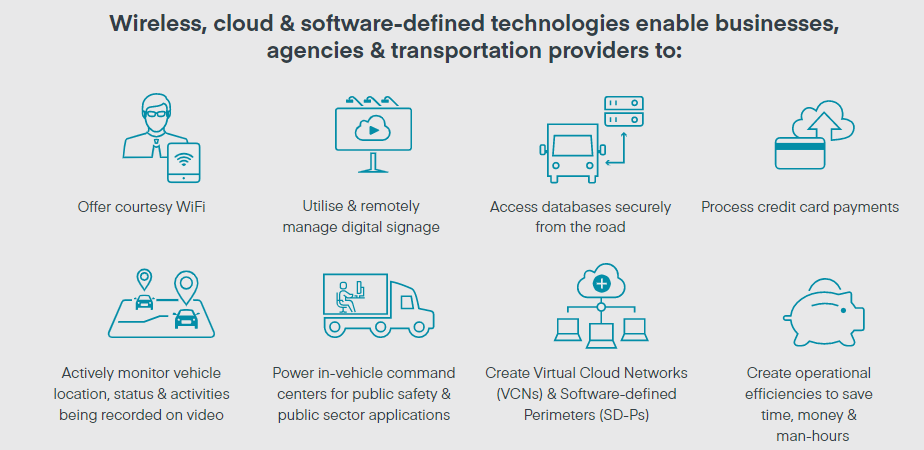IOT TRANSIT
Networks on the Move
As the digital transformation in IT continues to create the need for an Elastic EdgeSM, traditional tethers to the central office have all but vanished. Physical boundaries continue to decrease in importance, and organisations of all types require constant and dependable in vehicle connectivity to keep up with changing business imperatives. Dependable mobile connectivity keeps vehicles on the road longer, helps enterprises better manage their fleets, and allows businesses and organisations to better serve their customers.

Top 10 Reasons Fleet Managers Use GPS Telematics
1. Driver behavior
2. Location information
3. Accurate odometer & engine hours
4. Asset utilisation
5. Fuel management (fuel level, fuel usage, HPG)
codes)
7. Route management
8. Customer service (ETAs, delivery, dispatch)
9. Crew productivity
10. Insurance (claims analysis, lower risk)
Application-Specific Considerations
Education & Mass Transit
When vehicle operators offer WiFi for passengers, the need for content filtering and policies that govern such filtering invariably arises. Education agencies are required to block certain types of sites, while transit authorities may wish to prevent downloads, streaming, and inappropriate content. Cloud security software and remote cloud management enable IT managers to customise content rules and traffic settings and be alerted to security vulnerabilities immediately.
Security
First responders, law enforcement, school buses, and businesses all benefit from the added security of deploying interior and exterior vehicle security cameras. Enterprises and agencies can leverage Internet connectivity to stream video feeds in real time and access recordings without docking the vehicle. Such immediacy can maximise the effectiveness and ROI of surveillance cameras. Under some circumstances, enterprises may not wish to expend the amount of cellular data required to offload video in real time. In those cases, it is preferable to have the option to quickly offload video via a secondary, non-metered WAN source.
Network Reliability
Many organisations use Virtual Private Networks (VPNs) to provide their mobile employees access to important data and applications housed at the organisation’s data center.
For fleet employees, from truck drivers to police officers, every minute counts; connecting to the VPN wastes precious time. The need to connect to the VPN can become a significant source of frustration and wasted time if employees must reconnect every time the LTE signal temporarily drops.
Fleet enterprises should consider deploying a software- defined virtual overlay network that can function as a mobile LAN, keeping vehicles authorised on the network even when the LTE signal is temporarily interrupted.
Parallel Networks
For organisations offering guest WiFi to passengers and requiring applications that carry critical data — like Point-of- Sale — it is a best practice to implement Parallel Networks, or physically air-gapped networks for maximum network security. Parallel Networks hinder hackers from gaining access to sensitive applications within in vehicle networks by pivoting from other areas, such as the guest WiFi or digital signage.
Fleet Management
Enterprises can use software with integrated geofencing technology to track vehicle routes and driver be haviour on the road. This intelligence allows fleet managers to monitor route efficiency, look for redundancies or wasted time, and reconfigure routes for maximum effectiveness.
On-Site Services & E-Commerce
Fleets can leverage secure Internet connectivity to offer customers on-site payments and input data. To protect customers and keep sensitive information secure, software with encrypted communication protocols safeguards against eavesdropping and helps mitigate the potential for a security breach.
Hot Spot Connectivity
Police, first responders, mobile healthcare providers, and many other organisations may need connectivity to extend well beyond the vehicle’s perimeter. This requires a router and management solution capable of delivering WiFi securely, as well as an external antenna able to extend the WiFi range.
Secure, Efficient Remote Database Access
WiFi for Passengers
Remote Monitoring, Maintenance & Updates
Solution: A software-defined, cloud-based remote management service can enable software/firmware updates, configurations, security patches, and maintenance of wireless devices from a remote location while ensuring that sensitive data stays safe. Also, because a mobile router on a cellular network utilizes dynamic, private IP addresses, the management service should not require a static IP to connect to the router.
One in five vehicles on the road will have a wireless network connection by 2020. 2
1 Source (Page 2) http://www.fleetanswers.com/sites/default/files/2016%20Telematics%20
Survey%20Report_0.pdf
2 Source http://www.gartner.com/newsroom/
id/2970017